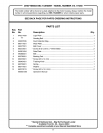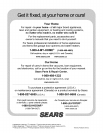
USINGTHE DUSTCOLLECTIONBAG
Thedustcollectionbagprovidesadustcollection
systemforthesander.
_lt WARNING"Donotusethedustcollectionbag
whensandingmetal.Usingthedustcollectionbag
whensandingmetalcreatesafirehazard,which
coulddamagethetoolandleadto seriouspersonal
injury.
TO ATTACH THE DUST COLLECTION BAG
See Figure 7.
Follow these steps to attach the dust collection bag.
• Unplug the sander.
_ WARNING: Failure to unplug the tool could result
in serious injury due to accidental starting.
• Slide thee dust bag retainer over the blower exhaust
hole on the sander.
Follow these steps to empty the dust collection bag.
• Unplug the sander.
_k WARNING: Failure to unplug the tool could result
in serious injury due to accidental starting.
• Remove the dust collection bag from the sander.
• Unzip the dust bag.
• Shake out the dust.
• Zip up the dust bag.
• Replace the dust collection bag.
Note: Periodically, you should turn the dust bag
inside-out and thoroughly clean it.
TURNING ON/OFF THE SANDER
See Figure 8.
Follow these directions to turn the sander on and off.
• To turn on the sander. Depress the trigger switch.
• To turn off the sander. Release the trigger switch.
\
\
\
\
TO EMPTY THE DUST COLLECTION BAG
For more efficient operation, empty the dust collection
bag when it is no more than half full. This action permits
the air to flow through the bag better. Always empty and
clean the dust collection bag thoroughly upon
completion of a sanding operation and before placing
the sander in storage.
_1 WARNING: Collected sanding dust from sanding
surface coatings such as polyurethanes, linseed
oil, etc. can self-ignite in your sander dust
collection bag or elsewhere and cause fire. To
reduce the risk of fire always empty your dust bag
frequently (10-15 minutes) while sanding and
never store or leave a sander without totally
emptying its dust bag. Also follow the
recommendations of the coatings manufacturers.
LOCK-ON
BUTTON
TRIGGERSWITCH
12


















